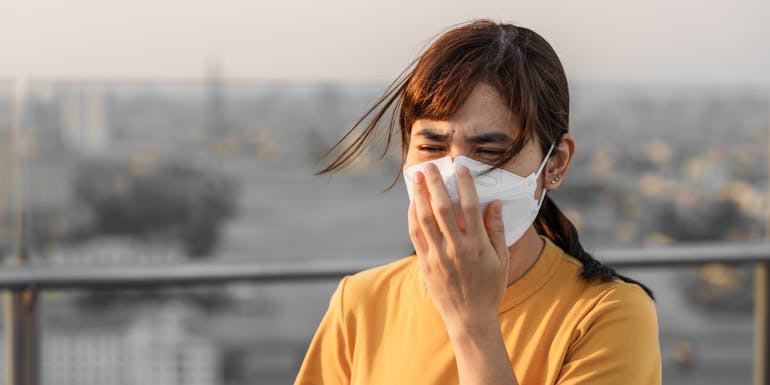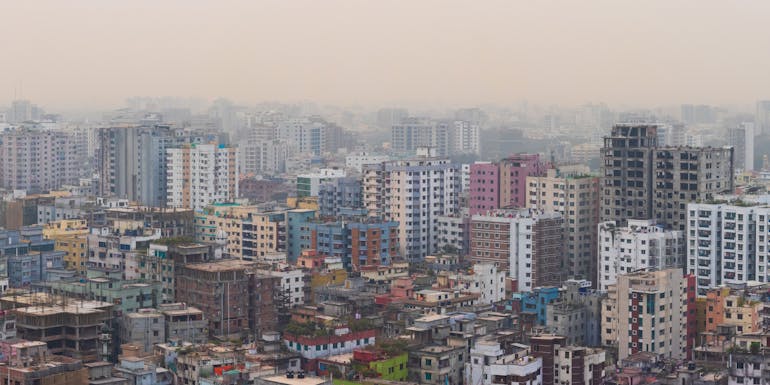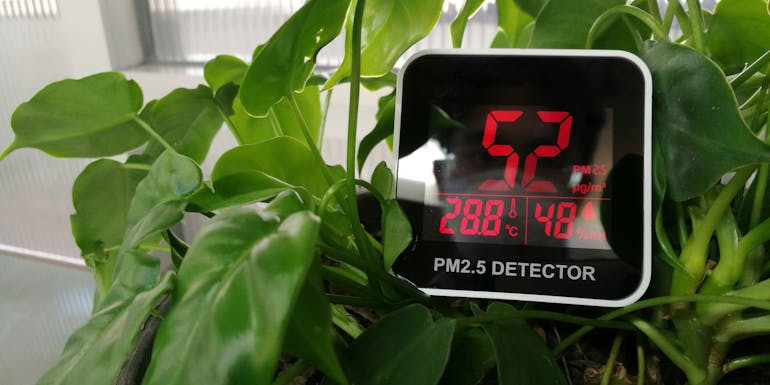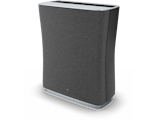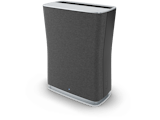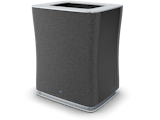
Nadine Walder, 17 avril 2024
Purification de l'air
Poussières fines : tout ce que tu dois savoir sur elles
Dans les zones urbaines densément peuplées de notre monde, les particules fines représentent une menace sérieuse qui pose de grands défis. Ses effets s'étendent au-delà de l'environnement et affectent directement notre bien-être. À long terme, les particules fines peuvent entraîner de nombreux problèmes de santé. Pour lutter contre la pollution de l'air, il faut avant tout des efforts collectifs de la part du secteur privé, de la politique et de la société civile. Nous t'expliquons tout ce qui concerne les particules fines, comment tu peux agir toi-même et ce que tu peux faire chez toi pour que toi et tes proches puissiez respirer un air pur.
C'est ce que tu apprendras dans cet article :
- Qu'est-ce que la poussière fine ?
- La pollution par les particules fines et ses conséquences potentielles sur la santé
- La pollution de l'air en comparaison internationale
- Efforts mondiaux de lutte contre la pollution de l'air
- Améliorer la qualité de l'air : que peut-on faire ?
Qu'est-ce que la poussière fine ?
Les poussières fines, également appelées particules fines, sont de toutes petites particules qui flottent dans l'air. On peut à peine les voir à l'œil nu, car elles sont minuscules. Elles sont par exemple produites par les gaz d'échappement des voitures, les travaux de construction, la fumée des processus de combustion ou la cuisson des aliments.
Les particules fines sont un mélange complexe composé de particules primaires et secondaires. Les particules primaires sont directement produites par les processus de combustion, l'abrasion mécanique des pneus et les sources naturelles, tandis que les particules secondaires se forment dans l'air à partir de précurseurs gazeux (par exemple, les composés organiques volatils, le dioxyde de soufre ou l'ammoniac). La taille des particules varie, mais elles sont si minuscules qu'elles peuvent pénétrer profondément dans nos voies respiratoires, ce qui renforce leurs effets potentiellement nocifs sur notre santé.
La pollution par les particules fines et ses conséquences potentielles sur la santé
FLes particules de poussière fine peuvent être de différentes tailles. Lorsqu'on parle de poussières fines, on distingue en principe les particules PM2.5 et les particules PM10. Ces particules tirent leur nom de leur diamètre inférieur à 2,5 ou 10 millièmes de millimètre. À titre de comparaison, un cheveu humain a une épaisseur moyenne de 0,05 à 0,08 mm et une feuille de papier normale a une épaisseur de 0,1 mm. Les particules PM2.5 sont particulièrement dangereuses, car elles pénètrent profondément dans les voies respiratoires et les poumons et peuvent même passer dans le sang. En revanche, les particules PM10 sont plutôt irritantes et pénètrent plus rarement en profondeur dans les poumons.
Une exposition prolongée aux particules fines peut notamment entraîner une inflammation locale des voies respiratoires et provoquer de graves problèmes de santé, dont la toux, la dyspnée, la bronchite, les crises d'asthme, les maladies cardiovasculaires et même le cancer du poumon. En raison de ces conséquences potentiellement graves pour notre bien-être et notre santé, il est important que les responsables politiques, le secteur privé et la société civile luttent activement contre la pollution atmosphérique.
Les poussières fines constituent également un problème pour les personnes allergiques. La pollution par les particules fines peut aggraver les symptômes d'allergie, notamment en cas de rhume des foins et d'asthme. Une raison possible pourrait être que les poussières fines se fixent sur les pollens et les rendent plus allergènes. Selon le Swiss Medical Forum, il est évident depuis quelques années qu'il existe un lien entre la pollution de l'air, le changement climatique et les allergies respiratoires.
La pollution de l'air en comparaison internationale
Dans ses directives vde 2021, l'OMS recommande une limite annuelle de 5 µg/m³ pour les particules PM2.5. Malheureusement, de nombreuses villes dans le monde dépassent plusieurs fois ces valeurs. À peine dix pays ou territoires sont restés en dessous de ce seuil en 2023.
Selon les derniers chiffres du World Air Quality Report 2023, des villes comme New Delhi, Dhaka ou Jakarta comptent parmi les villes les plus polluées au monde, avec le plus grand nombre de décès annuels qui en découlent directement. À une exception près, tous les pays du top 10 se situent en Asie. En revanche, les pays européens ont presque tous amélioré leurs résultats. Seuls 6 pays sur 42 ont vu leur score se dégrader.
Efforts internationaux en matière de pollution de l'air
La pollution de l'air est un problème urgent qui provoque, par exemple, un demi-million de décès prématurés par an dans a seule Région européenne de l'OMS, principalement en raison de maladies telles que les accidents vasculaires cérébraux, les cardiopathies ischémiques, la bronchopneumopathie chronique obstructive (BPCO) ou le cancer du poumon. L'OMS appelle à intensifier les efforts conjoints pour purifier l'air, et souligne la nécessité de partenariats, d'investissements et de responsabilités partagées.
Les principales sources de pollution atmosphérique sont multiples et vont des émissions du secteur de l'énergie aux émissions des transports, des processus industriels aux activités telles que la cuisine et le chauffage. Des mesures de grande envergure sont nécessaires et doivent être mises en œuvre non seulement au niveau national, mais aussi au niveau international.
La Déclaration de Budapest, adoptée lors de la « Septième Conférence ministérielle sur l'environnement et la santé », souligne l'urgence et la nécessité de prendre des mesures pour relever les défis sanitaires liés à la pollution, à la perte de biodiversité et au changement climatique. Elle met l'accent sur le renforcement de la gouvernance, l'investissement dans les ressources humaines et la promotion des connaissances et des outils d'action.
Les responsables politiques disposent de plusieurs mesures et instruments pour lutter contre la pollution de l'air. Les Lignes directrices mondiales pour la qualité de l'air de l'OMS fournissent des recommandations fondées sur des données probantes concernant la qualité de l'air et guident les responsables politiques dans la définition de normes et d'objectifs pour maintenir la pureté de l'air. La mobilisation de mesures délibérément transversales et le renforcement de la collaboration transfrontalière sont essentiels pour réduire la pollution atmosphérique et protéger la santé.
Les efforts de lutte contre les particules fines nécessitent une interaction entre la politique, le secteur privé et la société civile. Tu peux toi aussi participer activement à l'amélioration de la qualité de l'air au niveau local. Il y a aussi des choses que tu peux faire pour améliorer la qualité de l'air chez toi et y respirer un air plus propre.
Améliorer la qualité de l'air : que peut-on faire ?
Afin de réduire la pollution par les particules fines, les particuliers peuvent prendre quelques mesures pour diminuer leur contribution personnelle à la pollution de l'air et protéger leur santé.
- Informe-toi sur le niveau de pollution de l'air dans ton lieu de résidence et surveille la qualité de l'air dans ta maison. La qualité de l'air peut être mesurée à l'aide d'appareils de mesure spéciaux.
- Réduis ta propre contribution à la pollution aux particules fines en utilisant les transports en commun ou en faisant du covoiturage plutôt que de prendre ta propre voiture.
- Si tu ne veux ou ne peux pas renoncer à ta propre voiture, fais-la réviser régulièrement.
- Évite de brûler les déchets agricoles et ménagers.
- Utilise si possible des sources d'énergie renouvelables, par exemple des panneaux photovoltaïques sur le toit de la maison, des pompes à chaleur qui extraient la chaleur de leur environnement ou des chauffages à pellets.
- Surveille tes propres besoins en énergie et utilise des appareils et des ampoules à faible consommation d'énergie.
- Pour améliorer la qualité de l'air dans ta maison et respirer un air pur, tu peux investir dans un purificateur d'air performant. Celui-ci peut filtrer les plus petites particules de l'air et contribuer ainsi de manière décisive à la réduction de la pollution par les poussières fines dans ton appartement ou ta maison.
Les particules fines sont une menace invisible, mais sérieuse pour notre santé. En étant conscients des sources et en prenant des mesures pour réduire la pollution par les particules fines, nous pouvons protéger notre santé. L'utilisation d'un purificateur d'air performant est à cet égard une solution efficace pour améliorer la qualité de l'air dans ta maison et créer un environnement de vie sain.
Tu veux en savoir plus sur la purification de l'air ? Sur notre page d'information, tu trouveras des conseils et astuces utiles ainsi que tout ce qui concerne la purification de l'air à l'intérieur.
En savoir plus sur la purification de l'air
Nous sommes à ta disposition pour toute question concernant le climat intérieur. Tu peux aussi t'inscrire à notre newsletter pour être informé régulièrement sur des sujets d'actualité, recevoir des témoignages sur nos produits ou lire Stadler Form Insights.

